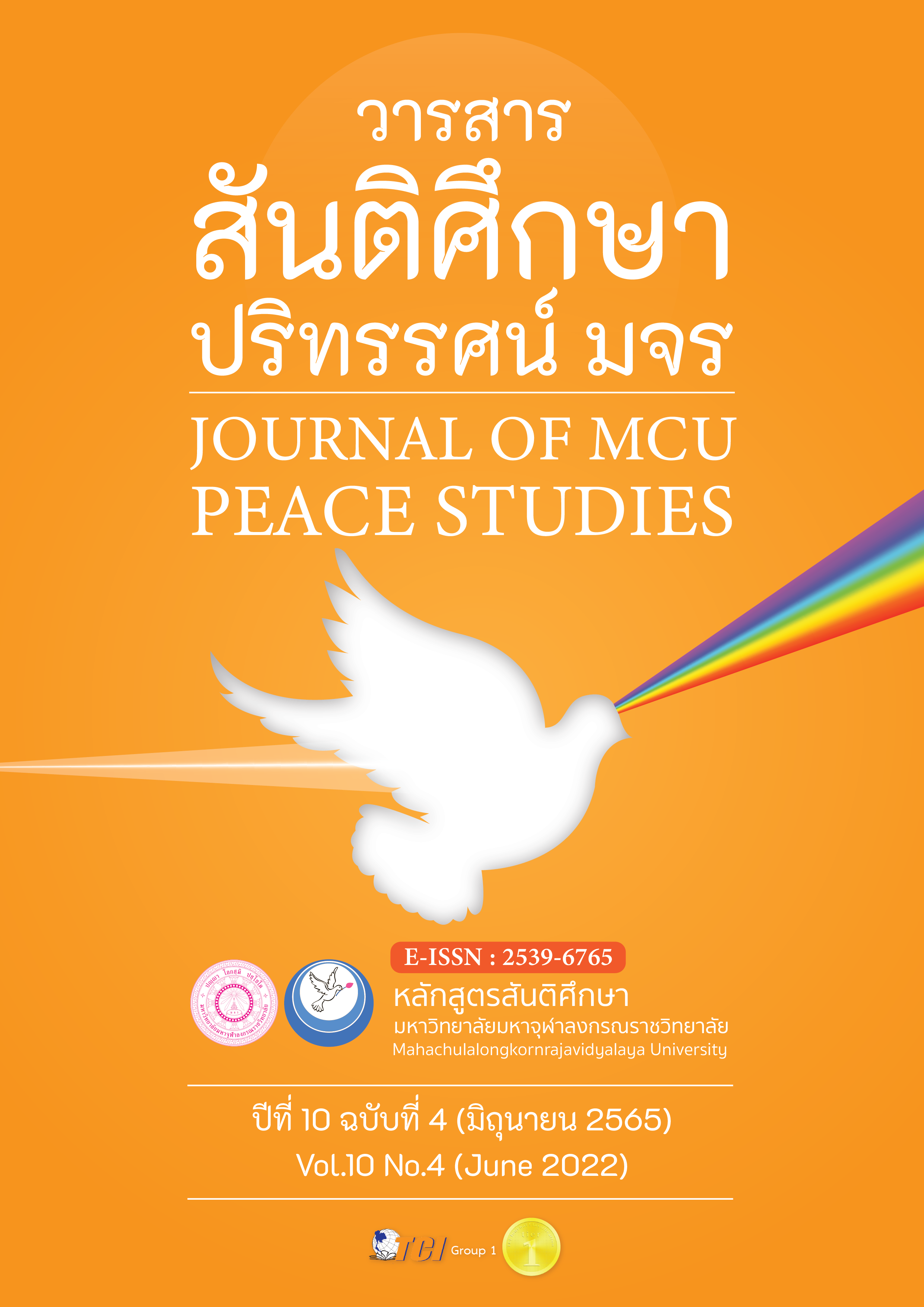ความสัมพันธ์เชิงสาเหตุของความเป็นผู้ประกอบการ ความคิดสร้างสรรค์และนวัตกรรมขององค์การที่ส่งผลต่อผลการดำเนินงาน ด้านการเงินของธุรกิจขนาดกลางและขนาดย่อม
Main Article Content
บทคัดย่อ
บทความวิจัยครั้งนี้ มีวัตถุประสงค์เพื่อ 1) ศึกษาความสอดคล้องของแบบจำลองเชิงโครงสร้างจากการทบทวนวรรณกรรมกับข้อมูลเชิงประจักษ์ 2) ศึกษาแบบจำลองความสัมพันธ์เชิงสาเหตุระหว่างความเป็นผู้ประกอบการขององค์การ ความคิดสร้างสรรค์ในองค์การ นวัตกรรมขององค์การ และผลการดำเนินงานด้านการเงินขององค์การธุรกิจขนาดกลางและขนาดย่อม ประชากรที่ใช้ในการวิจัยคือ ผู้บริหารระดับกลาง-สูงที่ทำงานในบริษัทจดทะเบียนในตลาดหลักทรัพย์ เอ็ม เอ ไอ จำนวน 4,760 คน กำหนดขนาดกลุ่มตัวอย่างตามพารามิเตอร์ ซึ่งมีจำนวน 51 พารามิเตอร์ ตามเกณฑ์ของ Hair ได้จำนวนกลุ่มตัวอย่างจำนวน 336 คน ด้วยเทคนิคการสุ่มตัวอย่างแบบหลายขั้นตอน เครื่องมือที่ใช้ในการวิจัย คือ แบบสอบถาม สถิติที่ใช้ในการวิจัยได้แก่ ร้อยละ ค่าเฉลี่ย ส่วนเบี่ยงเบนมาตรฐาน การวิเคราะห์องค์ประกอบเชิงยืนยัน และการวิเคราะห์รูปแบบสมการโครงสร้างเชิงเส้น
ผลการวิจัย พบว่า 1) แบบจำลองเชิงโครงสร้าง มีความสอดคล้องกับข้อมูลเชิงประจักษ์ ด้วยค่าดัชนีความสอดคล้อง χ2 =55.082, df= 51, χ2/df=1.020, p=0.433, RMSEA= 0.008, GFI=0.978, AGFI=0.957, CFI=1.000 2) ความเป็นผู้ประกอบการในองค์การ มีอิทธิพลทางตรงเชิงบวกต่อผลการดำเนินงานทางการเงินขององค์การ ความเป็นผู้ประกอบการในองค์การ มีอิทธิพลทางตรงเชิงบวกต่อความคิดสร้างสรรค์ในองค์การและนวัตกรรมขององค์การ ความคิดสร้างสรรค์ในองค์การ มีอิทธิพลทางตรงเชิงบวกต่อนวัตกรรมองค์
การ ความคิดสร้างสรรค์ในองค์การ มีอิทธิพลทางตรงเชิงบวกต่อผลการดำเนินงานทางการเงินขององค์การความคิดสร้างสรรค์ในองค์การมีอิทธิพลทางตรงเชิงบวกต่อนวัตกรรมองค์การ และนวัตกรรมองค์การ มีอิทธิพลทางตรงเชิงลบต่อผลการดำเนินงานทางการเงินขององค์การ
Article Details

อนุญาตภายใต้เงื่อนไข Creative Commons Attribution-NonCommercial-NoDerivatives 4.0 International License.
ทัศนะและความคิดเห็นที่ปรากฏในบทความในวารสาร ถือเป็นความรับผิดชอบของผู้เขียนบทความนั้น และไม่ถือเป็นทัศนะและความรับผิดชอบของกองบรรณาธิการ ยินยอมว่าบทความเป็นลิขสิทธิ์ของวารสาร
เอกสารอ้างอิง
organizational innovativeness of large enterprises in Thailand. Unpublished
doctoral dissertation, Bangkok University, Bangkok, Thailand.
Aktan, B., & Bulut, C. (2008). FinancIal performance impacts of corporate entrepreneurship in emerging markets: A case of Turkey. European Journal of Economics, Finance and Administrative Sciences, 12(8), 1530-2275.
Amabile, T. M. (1988). A model of creativity and innovation in organizations. Research in
Organizational Behavior, 10(1), 123–167.
Arbuckle, J. L. (2012). Amos 21 user’s guide. Chicago, IL: IBM SPSS.
Ayudurai, S & Sohail, M.S. (2005). Corporate entrepreneurship in Multinational Subsidiaries in
Malaysia: The Effects on Past Performance. Paper presented at 12th Annual
International Conference on Advances in Management. Binary School of
Management and Entrepreneurship, Malaysia: Retrieved November 20, 2006.
Barrett, R., Burgess, J., Boohene, R., Sheridan, A., & Kotey, B. (2008). Gender, personal values, strategies and small business performance: A Ghanaian case study. Equal Opportunities International, 27(3), 237-257.
Brown, J. (2016). From Creativity to Team Innovation: Building the Bridge in Organizations.
García-Morales, V. J., Jiménez-Barrionuevo, M. M., & Gutiérrez-Gutiérrez, L. (2012).
Transformational leadership influence on organizational performance through
organizational learning and innovation. Journal of Business Research, 65(7), 1040–
1050.
Gretzinger, S., Hinz, H., & Matiaske, W. (2010). Cooperation in innovation networks: The case of Danish and German SMEs. Management Revue, 193-216.
Gumusluoğlu, L., & Ilsev, A. (2009). Transformational leadership and organizational
innovation: the roles of internal and external support for innovation. Journal of
Product Innovation Management, 26(3), 264–277.
Hornsby, J. S. (2005). A model of middle-level managers’ entrepreneurial behavior.
Entrepreneurship Theory and Practice, 29(6), 699-714.
Jason, R. F. Eavn, J. D. Anntoncic, B., & Hisrich, R. D. (2005), " Intrapreneurship in Australin
fims." Journal of Australian and New Zealand academy of management. 11(1), pp.
17-27
Karacaoglu, K., Bayrakdaroglu, A., & San, F. B. (2012). The impact of corporate entrepreneurship on firms’ finanOIal performance: Evidence from Istanbul stock exchange firms. International Business Research, 6(1), 163.
Morris, M. H., Kuratko, D. F., & Covin, J. G. (2010). Corporate Entrepreneurship & Innovation. Mason. OH: Thomson South-Western.
Oke, A., Munshi, N., & Walumbwa, F. O. (2009). The influence of leadership on innovation
processes and activities. Organizational Dynamics, 38(1), 64–72.
Pretorius, M., Millard, S. M., & Kruger, M. E. (2005). Creativity, innovation and implementation:
Management experience, venture size, life cycle stage, race and gender as
moderators. South African Journal of Business Management, 36(4), 55–68.
Shahzad, K., Bajwa, S. U., Siddiqi, A. F. I., Ahmid, F., & Raza Sultani, A. (2016). Integrating
knowledge management (KM) strategies and processes to enhance organizational
creativity and performance: an empirical investigation. Journal of Modelling in
Management, 11(1), 163–179.
Sarooghi, H., Libaers, D., & Burkemper, A. (2015). Examining the relationship between
creativity and innovation: A meta-analysis of organizational, cultural, and
environmental factors. Journal of Business Venturing, 30(5), 714–731.
Sethibe, T., & Steyn, R. (2016). Organizational Climate, Innovation and Performance: A Systematic Review.Journal of Entrepreneurship and Innovation in Emerging Economies, 2(2),161-174.
Shamsuddin, S., Othman, J., Shahadan, M. A., & Zakaria, Z. (2012). The dimensions of corporate entrepreneurship and the performance of established organization. ACRN Journal of Entrepreneurship Perspectives, 1(2), 111-131.
Sullivan, D. M., & Ford, C. M. (2010). The alignment of measures and constructs in organizational research: The case of testing measurement models of creativity. Journal of Business and Psychology, 25(3), 505-521.
Schumacker, R. E., & Lomax, R. G. (2010). A beginners guide to structural equation modeling.
New York: Routledge
ก้องเกียรติ บูรณศรี. (2553). ความสัมพันธ์ระหว่างความเป็นผู้ประกอบการในองค์การ สภาพแวดล้อมทาง
ธุรกิจและผลการดำเนินงานของสถานประกอบการอุตสาหกรรมการผลิตขนาดกลางและขนาดใหญ่ ในพื้นที่การนิคมอุตสาหกรรมแห่งประเทศไทย. ปริญญาบริหารธุรกิจดุษฎีบัณฑิต. มหาวิทยาลัยธุรกิจบัณฑิตย์ กรุงเทพฯ: มหาวิทยาลัยธุรกิจบัณฑิตย์.
ทศพร บุญชัยวัชราภัย. ความคิดสร้างสรรค์ขององค์การเพื่อสร้างนวัตกรรมบริการ และผลการดำเนินงาน
ของธุรกิจ: ปรากฏการณ์เชิงประจักษ์ของโรงแรมบูติก ไทย. มหาวิทยาลัยศิลปากร.
พีรวุฒิ ศิริศักดิ์. (2016). ความสัมพันธ์เชิงสาเหตุของภาวะผู้นำการเปลี่ยนแปลง ความคิดสร้างสรรค์
ในองค์การนวัตกรรม องค์การที่มีต่อผลการดำเนินงานขององค์การ: ศึกษาวิสาหกิจขนาด
กลางแลขนาดย่อม. วารสารวิทยบริการ มหาวิทยาลัยสงขลานครินทร์| Academic Services
Journal, Prince of Songkla University, 27(3), 11–23.


